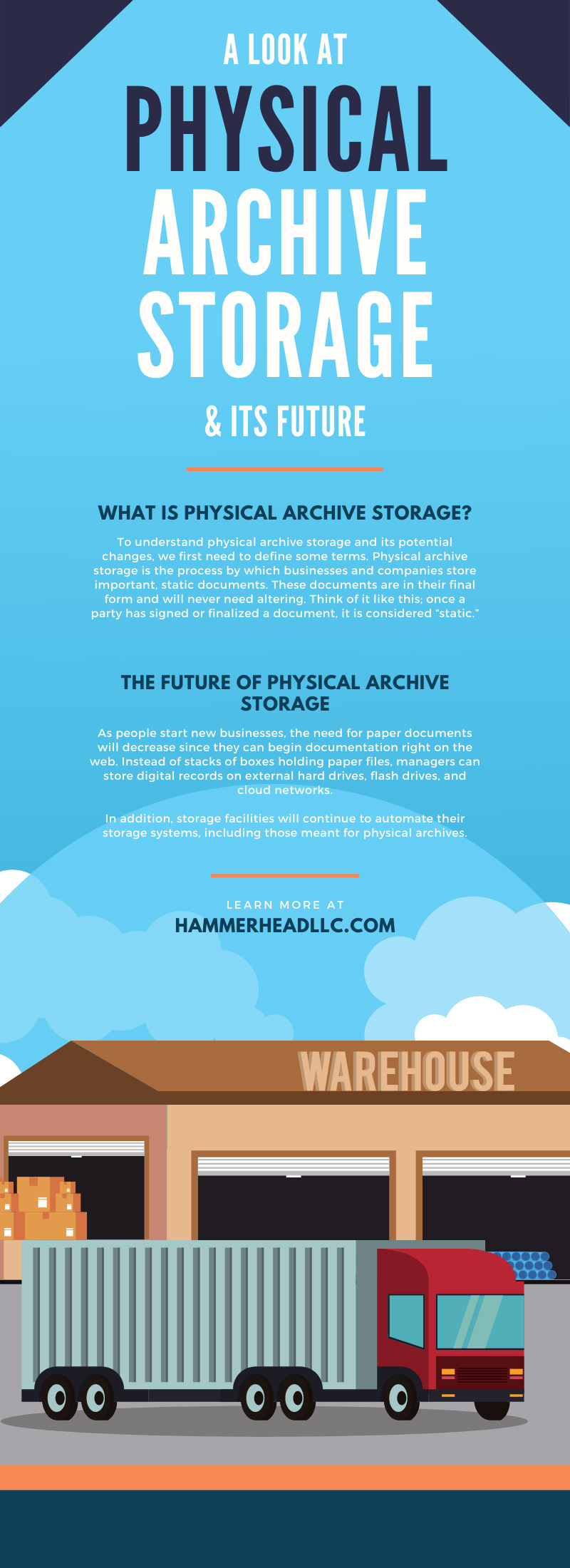No matter what business you’re in, you probably have large piles of physical documents lying around waiting for organization. This is especially true if you started your company before the rise of the internet. In the past, supervisors would handle file storage on or off-site, leaving a paper trail that was difficult to manage.
However, physical document storage is becoming more complicated as society continues to shift to online alternatives. This isn’t to say that document storage is obsolete; most companies have important paper files that they have to hold on to. Let’s take a look at physical archive storage and its future as the world conforms to the digital sphere.
What Is Physical Archive Storage?
To understand physical archive storage and its potential changes, we first need to define some terms. Physical archive storage is the process by which businesses and companies store important, static documents. These documents are in their final form and will never need altering. Think of it like this; once a party has signed or finalized a document, it is considered “static.”
There are several terms that many people confuse with physical archive storage, such as backup storage and document storage. While these terms are similar, they aren’t interchangeable. Let’s examine the nuances between these phrases.
- Archived Documents: These documents will never change and are in their original forms. Businesses usually retain these documents for legal purposes.
- Backup Data: This is a copy of the original documents. Managers typically store these copies at a different location in case something is lost or sustains damage.
- Document Storage: Document storage is a broad term that covers both static and dynamic documents. While archived documents will never change, other files may be temporary or may undergo alterations in the future.
How To Effectively Archive Documents
Physical archive storage isn’t something you do once and never touch again. It’s an ongoing process that should change as experts develop new techniques and technologies. However, as it currently stands, there is a general format managers can follow to optimize their current archived storage system.
1: Assess Your Current Methods
If you’re looking for information about physical archive storage and its future, you’re probably unhappy with your current storage methods. The first step to effectively archiving your documents is to evaluate your present process.
Ask yourself some questions about how you create, process, and store records. You should also take inventory of what kinds of files you store. This information will allow you to see where you’re lacking in the archive storage department and where you should make changes.
2: Establish Intentions and Goals
Now that you have a good idea about what you’re working with, you’ll need to set your intentions and goals for your new archived storage method. There’s a reason why you’re seeking advice on physical archive storage, so identify these reasons and start setting achievable goals.
Every company has different needs, so objectives surrounding storing archived documents may vary from place to place. Your intentions and goals may look something like this:
- My intention is to boost productivity. My goal is to implement a storage system that allows quick and easy access to old files.
- My intention is to lower overall business costs. My goal is to spend less money on my physical archive storage to reduce spending.
- My intention is to update my current system to better reflect current times. My goal is to incorporate new and improved technology into my file organization system.
3: Create a Retention Schedule
Now that you know what to change and have goals to pursue, the next step to storing your physical archives is to create a retention schedule. This step involves researching local, state, and federal laws surrounding archived documents. Depending on your location and nature of business, these policies may look different from company to company.
Find out which documents you need to hold on to and for how long. Then, shred and destroy all paper files you don’t need to keep, like junk mail, copies, and documents older than the recommended retention period. Make sure you continually check and discard files that you don’t need to free up space.
4: Find a Storage Provider
Once you’ve sorted through your files and know how long you need to keep them, you’ll need to find a place to hold them physically. If you have a large warehouse on-site, you can install archive storage racks to hold all of your paper files. If you don’t have enough space or are just starting your business, you can find a third-party storage facility to house all of your important documents.
The Future of Physical Archive Storage
Because technology has become so integral to everyday operations in almost all industries, the future of physical archive storage looks incredibly different than it has in the past. As people start new businesses, the need for paper documents will decrease since they can begin documentation right on the web. Instead of stacks of boxes holding paper files, managers can store digital records on external hard drives, flash drives, and cloud networks.
In addition, storage facilities will continue to automate their storage systems, including those meant for physical archives. Specialized software and racks will take the hard work out of employees’ hands and make the picking and sorting process more efficient. As artificial intelligence technology continues to advance, robots will help write up records and develop integrated structures within documents through the use of complex algorithms.
The main prediction from experts is that new methods will profoundly disrupt the way entities usually store their physically archived documents. This disturbance in the process may result in backlash from business owners used to operating a certain way. However, most professionals agree that current archived storage techniques no longer fit with the times, so changes must happen to keep up with industry trends and maintain a competitive edge.
Businesses need to keep accurate records to operate at their best level, and this fact isn’t changing. Managers need to keep up with physical archive storage trends to ensure that their data is precise, secure, and easily accessible. Hammerhead Material Handling has the best resources to optimize your storage facilities, so contact us today to see how we can help!



